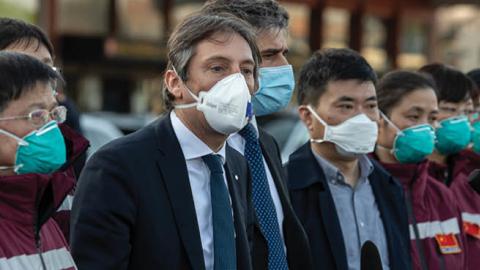View Full Report in PDF Format
Introduction
The outbreak of the novel coronavirus has introduced a series of new stresses and factors in the US-China relationship. While the world has struggled to contain the pandemic and its tragic repercussions, the People’s Republic of China has used the outbreak to launch a global campaign of misinformation, further its economic coercion through the Belt and Road Initiative, and continue military expansion efforts in the South China Sea.
China’s attempt to exploit the pandemic for political, strategic, and economic gain is problematic in the current environment, yet it is consistent with, and a continuation of, China’s long-term strategy. This report offers a global survey and assessment of attempts by the Chinese Communist Party (CCP) to expand its influence, including by exploiting the pandemic.
As the United States and its allies focus on combatting the virus and salvaging their economies, there is an opportunity to better understand China’s strategy and develop a unified response.
Following is a description of the essays in this volume:
ASIA
Beijing’s Continental Ambitions
Eric Brown highlights the role of landlocked Eurasia in China’s calculations for maritime dominance across the South China Sea and Indo-Pacific. Brown draws on China’s ongoing subjugation of the Xinjiang region as an example, along with the Chinese government’s systematic erasure of the region’s Islamic culture and practice. An effective US and allied response should establish counterpressures to China on both sides of Eurasia, along with offering strategic aid to Central Asian states aimed at de-risking greater private sector cooperation and indebtedness to Beijing.
US-China Competition in Northeast Asia
Patrick M. Cronin and H. R. McMaster outline how the political and economic fallout from the pandemic has led to a growing wariness of Xi Jinping’s intentions across South Korea and Japan, while China’s pressure tactics in Hong Kong and against Taiwan have increased tensions with its neighbors in Northeast Asia. The authors argue that stronger US bilateral relations with South Korea and Japan would help establish a free and open regional security environment and should begin with expanded cooperation on high technology and supply-chain security.
China’s Thrust into South Asia: Considerations for US Policy
Husain Haqqani, Aparna Pande, and Satoru Nagao outline China’s network of influence across South Asia and the CCP’s goal to limit defiance from India, the region’s major power. As the coronavirus pandemic slows economic growth in the region, Pakistan, Sri Lanka, and other South Asian countries caught in China’s debt-trap diplomacy will see their dependency deepen in the coming months, while India’s historic wariness of Beijing continues to deepen.
Meanwhile, the United States has begun to retool its approach to development and diplomacy in the region, using US government-funded agencies to offer private-sector funding for investments in infrastructure, energy, and technology projects across the Indo-Pacific.
China’s COVID-19 Opportunities in Southeast Asia
John Lee examines Xi Jinping’s efforts to court small states in Southeast Asia, where China has already gained disproportionately large strategic benefits through state-directed investment and infrastructure building. While many Southeast Asian nations express private anger at Beijing for unleashing the virus, they have largely kept to the pre-pandemic playbook, and leaders from Cambodia, Myanmar, Singapore, and Malaysia have praised Xi publicly. Beijing has used the shift in global focus to advance its presence in the South China Sea, with a series of military actions and administrative claims on islands currently occupied by Vietnam. Lee argues that the US should support international inquiries into the origins and early spread of the virus, as suggested by Australian Prime Minister Scott Morrison, and embrace institutional solutions rather than only relying on bilateralism.
Countering China’s “Greater Periphery” Approach in the South Pacific
John Lee reveals the challenges faced by the South Pacific sub-regions of Polynesia, Melanesia, and Micronesia, where limited access to healthcare and ventilators has cause a heightened vulnerability to China’s efforts to gain a regional foothold through supply of these essentials. In early March 2020, China established the China-Pacific Island Countries Anti-COVID-19 Cooperation Fund, allocating about $1.9 million to assist island nations in purchasing Chinese medical equipment, as part of China’s “greater periphery” strategy. To counter these efforts, the United States and its allies must meet their current Official Development Assistance obligations to the region, consider a rapidly deployable contingency fund, and facilitate assistance through multilateral organizations such as the International Monetary Fund. Even relatively small amounts would make an enormous difference to many of these small states.
EUROPE AND THE ARCTIC
China Embraces Strategy’s First Dictum, Divide & Conquer
Seth Cropsey examines the role of Eastern and Southern Europe as the western terminus in China’s Belt and Road ambitions. Although China has cultivated economic influence with Greece, Bulgaria, Romania, Serbia, and Hungary, the current pandemic has caused apparent strains, as Eastern Europe buckles under a growing $75 billion trade deficit with China. Chinese gains in Eastern Europe, Cropsey notes, will jeopardize links between NATO’s eastern flank and its Anglo-Atlantic core.
Transatlantic Considerations for a Pacific Century
Peter Rough argues that the transatlantic alliance is important in countering China’s bid for economic and political influence in Europe. The alliance, built around the E3 countries of France, Germany, and the United Kingdom, would work in a coordinated fashion to tighten access to key technologies beyond current EU regulations; import US best practices on foreign investment; protect European industry from Chinese IP theft; and reduce vulnerability in strategic sectors. Without American guidance and support, Rough argues, the opportunity to build an unassailable alternative to China’s authoritarian capitalism will be lost.
Creeping Influence: China and the Arctic during the Pandemic
Liselotte Odgaard examines the Arctic region’s coronavirus-related vulnerabilities, which range from its limited health infrastructure to a drastic reduction in global demand for seafood, the region’s main export. Meanwhile, Beijing’s geopolitical interest in the Arctic continues unabated. China continues with the objectives of the “Polar Silk Road,” launched in January 2018, to extract natural resources, establish its own transportation infrastructure, and convert its growing economic power into political influence. Odgaard highlights US and Danish engagement with Greenland as a model for successful transatlantic cooperation and a method of reducing China’s regional power.
MIDDLE EAST AND AFRICA
Soft Power, Hard Fail: Chinese Coronavirus Diplomacy in Africa
Blaise Misztal reviews China’s diplomatic efforts in Africa, where initial positive impressions soured after reports of discrimination against a large African community in Guangzhou, China. The quick reversal of China’s coronavirus diplomacy in Africa highlights the obstacles facing an autocratic state attempting to wield soft power, particularly in countries where citizens are willing to question the impact of Chinese investment, involvement, and influence on their societies. In the longterm, Misztal notes, the pandemic will fuel growing political instability in Africa, providing China with additional opportunities for influence. The US should align its strengths directly with the emerging African voices of opposition to China and support their demand for more capable, just, and transparent governing institutions.
The China Factor in US-Israeli Relations
Douglas J. Feith explores Israel’s economic connections to China and the strain it has caused to the US-Israel relationship. China, Israel’s second-largest trading partner after the United States, has a considerable infrastructure presence and significant business investments in Israel, which pose risks to the US-Israeli relationship. Feith explores how the US and Israel can protect their strategic relationship by working together on a common threat assessment regarding China and by regulating foreign trade to protect critical infrastructure and industries.
The Coming Struggle with China over the Middle East
Michael Doran examines the possibility that the Middle East will become a contested arena between the United States and China, despite the current US focus on organizing allies in East Asia and Europe. Doran challenges prevailing assumptions that Beijing’s military contest with Washington is largely restricted to East Asia, noting that China’s port in Gwadar, Pakistan and its military base in Djibouti are signs of the broader Chinese presence to come. Djibouti and Gwadar alone will soon give China the ability to guard—or threaten—the two key choke points through which Middle Eastern oil flows.


























